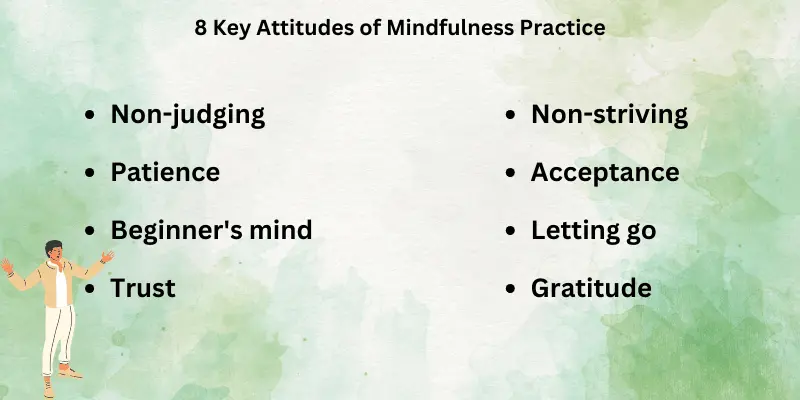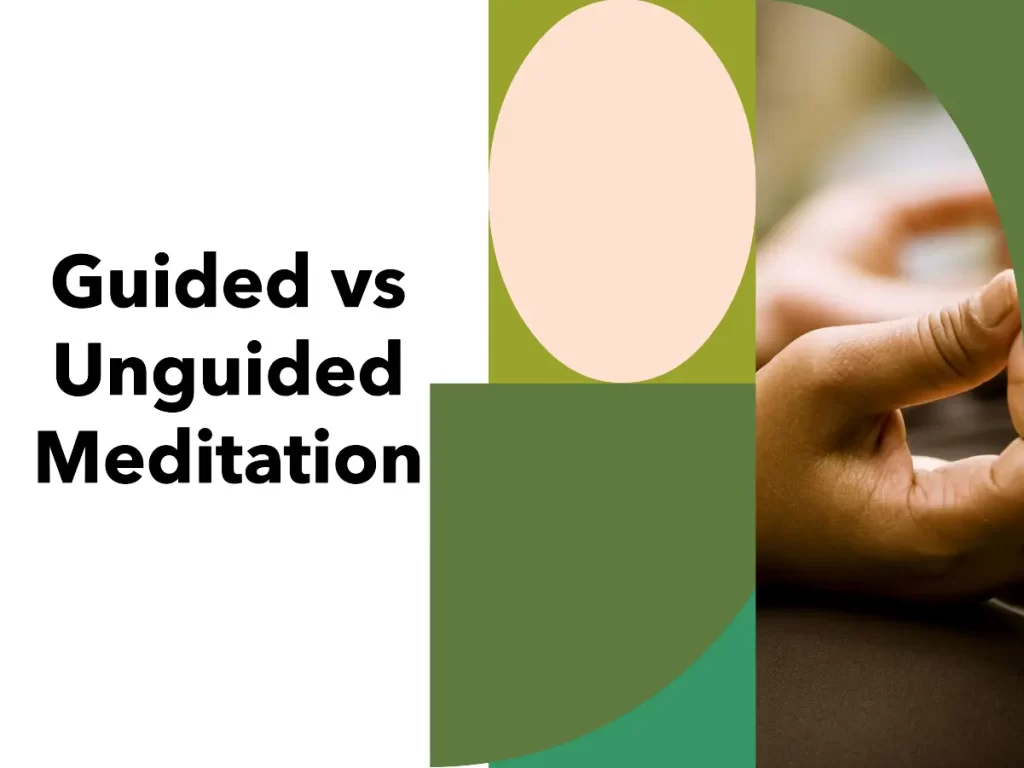As simple as mindfulness is, it can be subtle in application. You could make mistakes along the way. Even the attitude you possess while practicing mindfulness will go a long way to open doors for you. Read through this blog post so you can learn the answer to the question: what are the 8 key concepts of mindfulness? In other words, what attitude should you have when you are engaging in this practice?
Mindfulness: A Path to Inner Peace in Chaotic Times
Mindfulness is becoming a popular practice to release stress from your body. It has been defined by some as a technique where you notice what is happening in the present moment, without judgment. In this case, you notice or become aware of your mind, body and environment.
Mindfulness involves helping you to become self-aware. It moves you to become kinder to yourself and to successfully choose how to respond to negative thoughts. It works by guiding your mind away from wandering thoughts into the present moment awareness.
The history of mindfulness is traced to Ancient Eastern and Buddhist Philosophy. It dates back around 2500 years. The term comes from a Buddhist concept ‘Sati’ which means “moment to moment awareness of present events”. The modern translation of “Sati” to “Mindfulness” happened in 1881 when a man called Thomas William Rhys Davids identified it as so.
However, credit goes to Jon Kabat-Zinn and his colleagues at the University of Massachusetts for establishing it in the Western World. The first time Kabat-Zinn encountered mindfulness was through a Zen Buddhist meditation teachers named Philip Kapleau and Korean Zen Master Seung Sahn Haengwon.
He had further mindfulness training with teachers from other Buddhist traditions. He then secularized historical Buddhist mindfulness principles by separating them from cultural, religious and ideological factors. This made it possible for him to orient them in his mind and culture, leading to the development of what is called Mindfulness-Based Stress Reduction (MBSR).
In recent years, people have been taking interest in mindfulness. Countries in Europe and other parts of the world were reported to have mostly searched for mindfulness. Especially during the COVID-19 era, people were interested in finding out more about mindfulness. They believed that this can help them cope with mental problems and stress that the pandemic brought upon them.
In fact, the number of publications on mindfulness has been growing since. With the number being less than 100 per year, it shows that people are looking up to mindfulness to solve problems.
8 Key Attitudes of Mindfulness Practice


At this point, we will be giving answers to the question: what are the 8 key concepts of mindfulness? Let’s see how they can help us train the mind.
Non-judging
Thoughts may arise when we are being mindful. It is also common for us to be judgmental. We may begin to label experiences as good, bad, or neutral, depending on how these make us feel. If you must successfully complete this practice of mindfulness, then you should be not judge. Non-judging makes us not to get caught up in ideas. Mindfulness is cultivated by assuming the stance of a neutral or an impartial witness to our present moment experience. Let’s take an example.
If you are being mindful and you begin to notice your mind has wandered, instead of criticizing yourself or punishing yourself for being distracted, simply notice them and try to bring attention to your breath without judging. This will make you kind and compassionate to yourself.
Patience
Reaping the benefits of mindfulness is not something automatic. You just have to realize that things takes time and trying to alter nature can bring damaging effects to ourselves and others. For instance, imagine a child trying to help a butterfly emerge by opening its chrysalis. That would not help matters at all. Simply put, do not hurry the process.
Be patient when you are trying to unlearn a bad habit and when you are learning new ones. It’s okay to track progress. It is even natural to be concerned when you think the progress is slow but try not to think about it. Take the time to enjoy every moment and let things emerge in their own time.
Beginner’s mind
This means being willing to see everything through the eyes of a child – with delight, energy and freshness. It involves being innocent. This means you have to appreciate the beauty in everyday life. It could be hard to do so because of our beliefs which has shaped our thoughts and feelings, shielding us from seeing things the way they are. Take notice of the world as if you are seeing it for the first time. Keep your mind free from expectations and assumptions so you won’t get disappointed easily.
It’s just like walking into your room as if it is your first time. Or attending your next party or meeting as if it is your first time. What you experience at this point will make a huge difference.
Trust
Learning to trust yourself is a vital attitude that you need to cultivate within mindfulness. Mindfulness practice gives you an opportunity to trust your feelings and intuition. When you listen carefully to your feelings and intuition instead of forfeiting that to a group, we can become more aware of how our mind and body interact with each other.
Non-striving
As you approach mindfulness, it is good you start small. Try and do something less instead of setting a huge goal or target for yourself. This will ease your entrance and make your journey a memorable one. Pairing with this attitude is the feeling of being nonjudgmental. Just observe and pass. Stop overly worrying yourself over how to get things done in a more effective way. Just focus on being consistent and enjoy the journey. When you practice mindfulness without expectation of results, you cultivate the attitude of non-striving. This will in turn make you realize your aims more naturally.
Acceptance
Acceptance involves the ability to be receptive and take things the way they are. This is not the same with resignation or quitting. We know what is happening but we just want to focus on how we are responding. This attitude will prevent you from wasting time and energy denying things. It can lead to a more intentional way of living.
So the next time a negative feeling come up during mindfulness, do not try to ignore it by saying it is bad. Observe it without making judgments because they are there to teach you something.
Letting go
Normally, humans want to hold on to memories and emotions, especially good ones. Then, when it comes to bad ones, we try to keep them away by prolonging our attachment to the good memories. However, attaching ourselves to these are not helpful in any way. So, the next attitude you need to develop is to break free from them. Do not attach so much emotion to them, just let them go. Take a step back and observe all that is coming to your mind without judgment and you will see how quickly they pass.
Gratitude
As it is popularly known, grateful people are happy people. Gratitude brings a lot of physical, mental, and emotional benefits to us. It can make you energetic and positive. It can also release good hormones and promote good relationships with others.
Be grateful for the simple things in life.
A Training Program called Mindfulness-Based Stress Reduction
What name comes to mind? Apparently, Jon-Kabat Zinn, Ph.D. This man is a Professor of Medicine. His work has contributed to a growing movement of mindfulness. Apart from books, he owns an app, runs guided meditation programs and gives public talks on mindfulness.
The MBSR is an intensive training that combines mindfulness and self-regulation skills. In this training, participants learn to build a strong meditation practice. Participants are given daily home assignments. Classes are often in the form of presentation of information and discussion. MBSR has been shown to have many health benefits.
One notable one is in stress reduction. The American Psychological Association (APA) reports that individuals are able to manage their emotions effectively. Another benefit is pain relief. It also improves one’s quality of sleep and improve intuition. These are just some benefits of the program.
Cultivating Informal Mindfulness


One way to perfect mindfulness is through informal mindfulness. Here are some tips to help you go through with that:
- Start your day with mindful breathing.
- Express your gratitude by mentioning about 10 things you are grateful for. If you are having a hard time figuring it out, put them in paper.
- Observe nature or your environment. Return your attention on where you are at the moment. Pay attention to the sights, sounds, color, lights, vibrations and smells.
- Try to listen without responding or interjecting.
- Try not to say anything negative.
- Eat mindfully and do so with gratitude. Enjoy every mouthful like it’s your last.
Guided meditation apps and other resources can also help you easily sneak in mindfulness into your daily practice. We’ve arranged a list of the best ones for you.
- Headspace
- Calm
- Breathe
- Buddhify
- Oak, Meditation Studio
- The Mindfulness App
- Simple Habit
- iBreathe
Inarguably, being mindful helps improve productivity at work and foster good relationships. Here are some ways to be more mindful if you are not a mindful person.
- You need to cultivate humility. Humble people have quiet confidence in themselves. They are grounded and do not feel they need to do too much or be put in the spotlight.
- Pay attention to the way you interact with your colleagues. Actively listen and empathize with them.
- Try to adopt a growth mindset. That way, you won’t fear negative feedback. You will only view them as a chance to discover something new.
- Express gratitude to what your friends and others do for you. Make them feel appreciated.
- Create your own mindful workspace. Add elements that bring you joy and peace. Clear your desk of clutters. Make it neat and spicy.
The “Non-Doing” Aspects of Mindfulness
Two things that you should not do in mindfulness practice are striving for too much and holding on to memories for so long. Practice non-striving and letting go. This helps you focus on your current situation, to focus on non-doing instead of doing. It means you should understand and accept the fact that things happen without judging them. It means accepting things the way they are without trying to change it.
Mindfulness allows you to pay attention with a mirror-like quality of mind. Yes, a mirror reflects without changing anything on the object being reflected on it. Mindfulness can help to uncover the barriers to setting health expectations. It can prevent issues from coming up later on. It can help you live in the moment instead of questioning what is not right in your life. It also affords us the opportunity to review our internal thought process in order to live with positive hope.
Meditation training will help you cultivate this. In this instance, you are taught to embrace attachment instead of just cultivating a new mental state.
Mindfulness and its Transformative Influence


Mindfulness exercises cause physiological changes to the brain structure. In a group study, the effect of mindfulness on the brain of participants who underwent the MBSR training was studied. Results were compared with those who did not undertake the training.
They noticed an increase in gray matter density in the hippocampus. They also noticed decreased gray matter in the amygdala. As a result of these findings, they pointed out that mindfulness can bring mental and physical health benefits to individuals.
Some of the benefits include the enhancement of cognitive skills. It can also regulate emotions and improve focus and concentration. This technique can also reduce stress. It does so by altering the influence of the brain region responsible for stress responses. Additionally, mindfulness can successfully reduce the effects of anxiety and depression. It can also promote relaxation.
Mindfulness Practice Leads to Health at its Best
It is reported that mindfulness reduce anxiety levels by some 60%. It can also reduce the risk of heart disease by some 87%. In fact, more than half of employers recommend mindfulness to their employees. This is a testimony that indeed it improves one’s wellbeing. But that is not all.
Mindfulness lets you have kindness and compassion, not just for yourself but for others. This is because you become more responsible and alert to conversations and things happening around you. You are no longer lost or so concerned about yourself and what is happening to you.
Although the practice and benefits of mindfulness are thousands of years old, research is still going to develop more ways to make people more mindful. It is an evolving practice that will never fade away.
Try These 4 Best Mindfulness Interventions
- Do you know that with Mindfulness-Based Stress Reduction (MBSR) you can solve stress?
- A training with Mindfulness-Based Cognitive Therapy can help in metacognitive awareness.
- Dialectical Behavior Therapy (DBT) is on our third list, helping someone manage stress with mindfulness.
- The last we have on our list is Acceptance and Commitment Therapy (ACT), which effectively treats mood disorders.
Mindfulness Resources You Can Find at PositivePsychology.com
- The Wheel of Awareness: This is available in script and audio format to help clients boost their self-awareness.
- Eye of the Hurricane: Clients uses sensations of their breaths to find inner peace.
Conclusion
Have you now seen what the 8 key concepts of mindfulness is? Of course. Give consideration to these as you start your practice. Your wellbeing depends on it.
FAQ’s
Q. Please can you list out the 7 pillars of mindfulness?
A. First, non-judgment. Second, beginner’s mind. Third, trust. Fourth, non-striving. Fifth, patience. Sixth, acceptance. Seventh, letting go
Q. What would you say are the 4 Ts of mindfulness?
A. 1. tune in 2. take a step back 3. take care 4. trust yourself
Q. Can you mention the 4 principles of mindfulness?
A. One is mindfulness of the body. The second is mindfulness of the mind. The third is mindfulness of feelings while the fourth is mindfulness of phenomena.
Q. What is Body scan Meditation?
A. It is known as the process of scanning your body for negative feeling in order to feel more connected to yourself.



